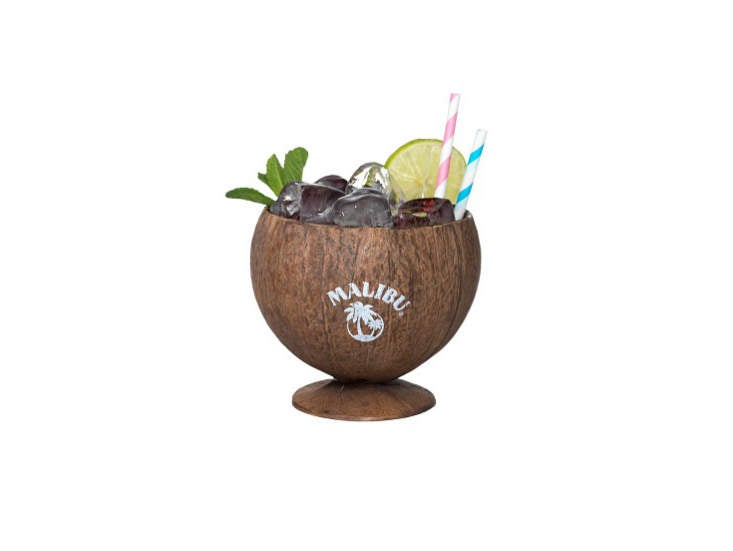

For party goers who are tired of waiting in queues at bars for their next drink, pioneering brand Malibu last year launched the internet-enabled Coco-nect cup, able to communicate with bar staff. Drinkers were able to place their next order by simply twisting the base of the cup – eliminating the need to wait in a queue, with bar staff delivering the drink straight to the customer’s hand.
Featuring internet of things (IoT) technology, the Coco-nect cups send signals to bar staff when a fresh drink is required. After the base of the cup has been twisted, the drinker’s exact location in the venue is triangulated, and then constantly tracked by bar staff. A light on the bottom changes colour when the drink is being prepared, which then starts flashing to help bar staff identify the right person when the drink is ready.
Developed in partnership with IoT agency SharpEnd, the Malibu Coco-nect cup is a drinks industry first, making use of existing WiFi and RFID (radio-frequency identification) technology. In an attempt to bring the internet of things to clubs and festivals in time for summer 2017, the brand’s aim is to “consign bar queues to the history books,” according to a Malibu press release.
Targeting young consumers who look for convenient and easy-to-use packaging solutions, the Coco-nect cups will attempt to abolish bar queues. “Traipsing to a crowded bar to face a lengthy queue for drinks can put a real dampener on many social get together,” explains Malibu global marketing brand manager, Deborah Nunez, “while our research shows that FOMO – or the ‘fear of missing out’ – can be a real frustration for young people who don’t want to miss out on the fun of the party.”
But the launch of these connected cups isn’t the first time the brand has tested IoT technology. In August last year, Malibu rolled out 40,000 connected bottles across the UK, allowing users with an NFC-enabled phone to access exclusive content, recipes, playlists and prizes at the ‘tap’ of a bottle. SharpEnd founder Cameron Worth helps explain connected technology.

US Tariffs are shifting - will you react or anticipate?
Don’t let policy changes catch you off guard. Stay proactive with real-time data and expert analysis.
By GlobalDataKatie Woodward: Can you tell us about the partnership between SharpEnd and Malibu? What brief did Malibu provide and how has the journey to deploy the NFC-enabled bottles progressed?
Cameron Worth: Malibu is owned by The Absolut Company (TAC), who are part of the Pernod Ricard group. SharpEnd has worked with TAC for more than two years and among other well-known initiatives has built an IoT innovation lab in their Stockholm HQ. The connected bottles programme is a product of the lab and is the first of many initiatives to hit the market over the next few years.
The pilot has launched to evaluate consumers’ willingness to interact with a product and which contextual experiences and services they are interested in.
KW: In layman’s terms, how does NFC – or near field communication – technology work?
CW: NFC is a passive ‘tag’ technology which sits on a product. When an NFC-enabled smartphone comes into contact with the product, the tag wakes up and launches a URL directly in the browser on the smartphone. This is where consumers could access competitions, mixcloud playlists and a bar locator app.
There are other uses of NFC but for now we see launching URLs serving as their main purpose for connecting brands to consumers.
KW: Which digital experience has been the most popular?
CW: Instant wins, which was surprising as there was a chance to win a seven night Barbados holiday. The insight was that users believed they had a better chance of winning the smaller prizes, so this was a learning [curve] for the brand and something we can apply in future to connected bottle initiatives.
KW: What information have you gathered from the trial about consumer appetite?
CW: We will be announcing results shortly, but we can already share that we hit our main KPIs and have proven NFC to be an intelligent choice for product packaging as a way of digitally connecting with consumers.
KW: How can digital connected technologies help drive brand loyalty?
CW: Malibu is a brand targeted at digital natives, and they are embracing the bottle as a media platform to engage this group in a new way. Serving personalised content with seamless technology improves the relationship consumers have with an otherwise passive product and allows us to be more in-tune with what sort of additional experiences they might be after.
KW: Are there plans for other connected products in the pipeline?
CW: We are working closely with Pernod Ricard and we are expecting to launch the connected bottle in multiple markets through 2017 and 2018. The eventual goal is to have connected bottles as a global initiative that markets can activate on a local level.
KW: Finally, what can we expect from the future of smart packaging solutions?
CW: NFC offers the best user experience for engaging with smart packaged products. Once the iPhone opens NFC capabilities we’ll see more brands coming to market with the same sort of technology offering, and this will hopefully create a critical mass ahead of the technology becoming a mainstream ‘thing.’



